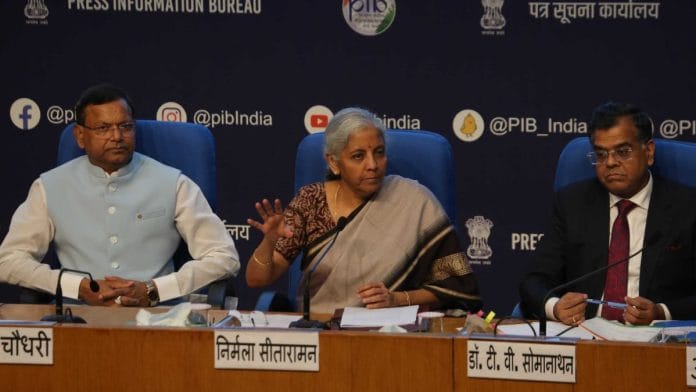The final 2024-25 Budget lays down considerable emphasis on future plans in the medium-term. Many of the announced schemes would take shape after carrying out suitable studies and bringing on board various other stakeholders including state governments.
The core growth strategy remains investment-focused with no strong initiative to incentivise private consumption expenditure. With fiscal consolidation, the government’s debt-GDP ratio and interest payments to revenue receipts ratio would fall, opening up additional fiscal space for capital spending.
Fiscal consolidation after the Covid-19 shock
The government’s fiscal deficit to GDP ratio shot up to 9.2 per cent in the Covid year of 2020-21. It was slowly brought down to 5.6 per cent in the next three years, implying an annual average reduction rate of 1.2 percentage points. After this, the annual rate of reduction has been halved to 0.7 per cent with the Government of India’s fiscal deficit to GDP ratio budgeted to fall to 4.9 per cent in 2024-25.
If an annual reduction of nearly 0.6 per cent on average can be managed for the next three years, the fiscal deficit of 3 per cent of GDP appears feasible by 2027-28. Alongside, the GoI’s debt-GDP ratio is estimated to fall from 60.7 per cent in 2020-21 to 55.7 per cent in 2024-25 (BE). This entails a reduction in the ratio of interest payments to revenue receipts from 41.6 per cent in 2020-21 to 37.2 per cent in 2024-25 (BE). This points to a virtuous cycle of falling fiscal deficit and debt and interest payments, progressively releasing additional fiscal space for capital expenditures.
Also read: Budget 2024 stays clear of populism, continues to create a path for fiscal consolidation
Investment led growth
The growth strategy in the presence of global economic headwinds and weak private investment demand has largely relied on expanding government investment expenditure focused on infrastructure augmentation. These investment expenditures are associated with high output and employment multiplier values. After maintaining an average annual growth of capital expenditure at 30.7 per cent during 2021-22 to 2023-24, in the 2024-25 Budget, a lower growth of nearly 17 per cent is being provided.
There is some doubt as to whether the GoI would be able to successfully and effectively spend even this much. In 2023-24, out of the budgeted amount of Rs 10 lakh crore, only Rs 9.5 lakh crore could be utilised as per the actuals released by the Controller General of Accounts (CGA). Further, in 2024-25, while the budgeted capital expenditure is Rs 11.11 lakh crore, capital outlay is lower by Rs 20,000 crore as compared to the interim budget.
Also read: Modi govt’s Budget 2024 plays unabashed appeasement politics—after borrowing Congress ideas
Co-opting states
The 2024 Budget indicates several channels through which the state governments can be co-opted in the growth process. First, there is an increase in the provision of tax devolution to the states as compared to the interim budget. The total amount of tax devolution to the states is now estimated at Rs 12.47 lakh crore, implying an increase of Rs 27,428 crore as compared to the interim budget. Second, states have been given long-term interest-free loans to the tune of Rs 1.5 lakh crore in 2024-25 to augment their capital expenditure.
Third, there is a focus on eastern states as part of an initiative called ‘Purvodaya’. Fourth, additional allocations for various schemes have been made for states including Bihar, Andhra Pradesh, Sikkim, Himachal Pradesh, and Assam. Fifth, some other proposed schemes in partnership with states include the development of industrial parks, the development of cities as growth hubs, and projects focusing on water supply, sewage treatment and solid waste management, among others.
Also read: Budget has complex political message. It shows BJP ko BASE pasand hai
Employment related initiatives
There has been a call for developing a counterpart to the existing production-linked incentives (PLI). The 2024-25 final budget has now taken the first steps toward developing an employment-linked incentive (ELI) scheme. This scheme has three parts: One, first-timers joining a formal workforce. Two, job creation in manufacturing related to first-time employees. And three, an employer-centric scheme covering all additional employment in all sectors within a salary of Rs 1 lakh per month. Additional incentives are being provided to facilitate higher participation by women in the workforce.
The Budget has also co-opted the private sector in the growth and employment augmentation initiatives by providing internship opportunities partially funded by the GoI and partially by the companies through their Corporate Social Responsibility (CSR) funds. These incentives will supplement the employment generation linked to GoI’s large capital expenditure.
As per the Reserve Bank of India’s KLEMS (Capital, Labour, Energy, Materials and Services) database, there has been an acceleration of absorption of working-age persons in agriculture as well as non-farm sectors mainly construction and trade from 2017-18 onwards, rising from 47.5 crore persons to 64.33 crore in 2023-24. The GoI has emphasised an employment strategy that promotes shifting workers from agricultural to non-agricultural sectors and from informal to formal sectors. This would help promote the formalisation and digitalisation of the economy.
A major point of concern relates to the government’s capacity both at the central and state levels to successfully and effectively undertake investment expenditures at least up to the extent of budgeted amounts. In the government’s case, there was an underspending compared to the budgeted amounts both in 2022-23 and 2023-24. In 2023-24 and 2024-25, the GoI extended a long-term interest-free loan facility to states amounting to Rs 1.3 lakh crore and Rs 1.5 lakh crore.
The offtake of these amounts by the states was partial in 2023-24 and this trend may continue in 2024-25 since the amounts would be available for spending only in the post-monsoon months. Thus, there are indications that the investment-led growth strategy appears to be decelerating.
DK Srivastava is Chief Policy Advisor, EY India and Member, Advisory Council to the Sixteenth Finance Commission. Views are personal.
(Edited by Zoya Bhatti)






